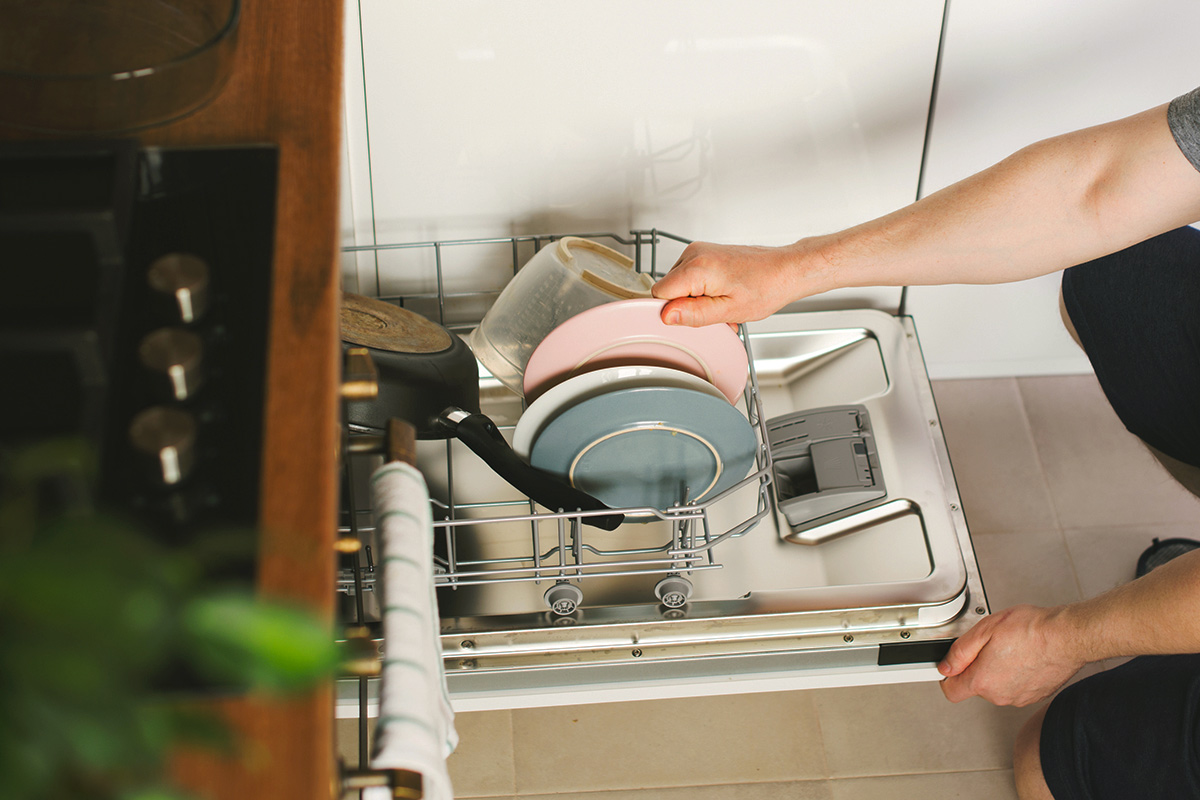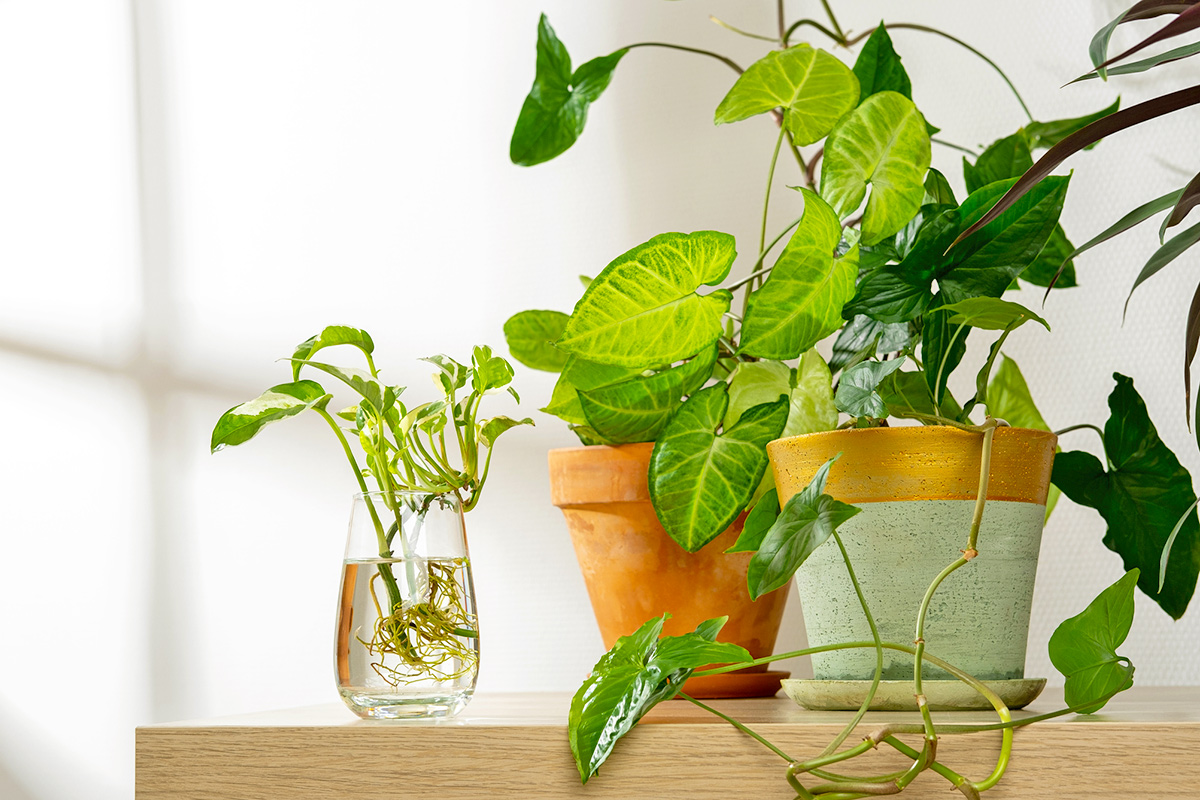Some people seem to have what we enviously call a “green thumb,” meaning plants under their care consistently thrive. Others of us fall at the opposite end of the spectrum, frequently lamenting how even the most promising plants fall victim to our “black thumb.”
If you belong to that second group, or are simply eager to bring some greenery into your home, we have good news: There are plenty of easy, beginner-friendly houseplants that are stubbornly hard to kill, even if you’re still learning how to care for them. Here are a dozen of the simplest ones to grow, from small and understated to big and flashy. We’ve also included a good mix of visual styles, featuring both flowering plants and those with dramatic foliage.
1. Air Plants (Tillandsia spp.)
Tillandsia, or air plants, are epiphytes, which means they grow on other plants rather than in soil. Right away, that eliminates a whole host of complications because you won’t need to fuss about soil, fertilizers, or pesky fungus gnats. You can keep tillandsia in something as simple as a saucer or a wine glass — they don’t need anything elaborate.
Give tillandsia indirect light and a thorough 10- to 20-minute soak in water about once a week (the timing varies depending on the type of tillandsia and the dryness of your climate). Adding a bromeliad fertilizer to the water once or twice a month will help them flourish.

2. Pothos (Pothos spp.)
Pothos is a large-leafed, ivy-like vining plant that’s practically indestructible. Its leaves, which may be variegated, gold-green, or a glossy dark green depending on the variety, are always big and attention-getting. As a climbing, sprawling vine, it’s good in hanging baskets or growing up a tall trellis or other support.
Pothos cheerfully adapts to most lighting conditions, even flourishing in low-light rooms where other plants struggle. Water it only when the soil is dry, and give it some diluted liquid fertilizer every few weeks in spring and summer, when it’s in peak “growth mode.” Once well established, pothos is forgiving of neglect and occasional missed waterings.

More from our network
House Outlook is part of Inbox Studio, which publishes content that uplifts, informs, and inspires.
3. Spider Plant (Chlorophytum comosum)
If you’re an arachnophobe, don’t worry: The spider plant doesn’t attract actual spiders. The name comes from its reproductive strategy, in which it produces new clumps called “pups” at the end of long runners, much like a strawberry plant. To a fanciful eye, the pups look a bit like spiders dangling from a web. The plants themselves have long, thin, variegated leaves in a variety of shades, and will grow quite happily despite neglect and poor lighting. The pups can be left in place to dangle and create a multitiered hanging plant, or rooted and used as a new plant for another corner of your home.
Spider plants prefer bright, indirect light and well-draining soil that should be kept consistently moist, but not wet. One of their few weak points is that they’re sensitive to chlorine and fluoride, so if you’re on a municipal water system, it’s best to use rainwater or other nonchlorinated water for these plants.

4. Dracaenas (Dracaena spp.)
Dracaenas are a large family of tropical plants, so diverse that you could fill your entire home with them, and each would look distinct. Snake plant (Dracaena trifasciata), lucky bamboo (Dracaena sanderiana), and the confusingly named corn plant (Dracaena fragrans) are three especially popular choices, and look nothing alike. As a bonus, a happy Dracaena fragrans will occasionally reward you with a spike of globular, clustered blossoms that are gloriously, sweetly fragrant (hence its scientific name).
Most dracaenas are easy to grow and tolerant of both low light and infrequent watering. They favor well-drained soil and need watering only when the top inch or two of soil feels dry to the touch. During spring and summer, when dracaenas are actively growing, they’ll benefit from a water-soluble fertilizer every month or so.



5. Holiday Cacti (Schlumbergera spp.)
The best-known Schlumbergera is the Christmas cactus, so-called because it blooms at that time of the year. Other varieties, such as Thanksgiving cactus and Easter cactus, are named for similar reasons. This means you can enjoy Schlumbergera blossoms throughout the cold months if you have a few different species. (They’re among our favorite winter-blooming houseplants.)
Similar to air plants, they’re epiphytes in their native habitat. However, as long as you provide Schlumbergera with indirect light and quick-draining soil, and treat them generally like other succulents (don’t overwater them), they’ll do fine. They’ll also benefit from an occasional application of liquid houseplant fertilizer during the summer months.

6. Aloe Vera
This is a very recognizable succulent, and many people keep one in or near their kitchen because of its soothing effect on burns (just crush or slice one of its thick leaves, then apply the clear, soothing gel to the affected area).
Like most succulents, aloe vera is quite low-maintenance. It prefers lots of light but will tolerate less, and favors quick-draining soil. Water it when the soil feels dry, or when its “spears” begin to lose their full, rounded look. A balanced liquid fertilizer in early spring and then again in early summer will stimulate growth, but remember it’s a slow-growing plant. On the upside, it’ll be years before you need to repot it.

7. Tradescantia zebrina
Tradescantias are a family of vining, ivy-like plants that do well in hanging baskets or as outdoor ground cover. The most common indoor varieties are Tradescantia zebrina, with its striped leaves, and T. fluminense, which has glossy green leaves.
Tradescantia prefers sunlight but tolerates moderate to low light, so it’s quite adaptable (though you’ll get better color and thicker growth with more light). Ordinary general-purpose potting soil is fine, but skip any moisture-retaining mixes. While fertilizing is optional, a diluted liquid fertilizer every month or so in summer will give you the best growth.

8. Moth Orchids (Phalaenopsis spp.)
Orchids have a reputation for being finicky, but with tens of thousands of species, some are more obliging than others. Moth orchids are among the easiest for beginners. They grow lavishly from surprisingly small pots and produce some of the most beautiful blossoms imaginable.
Orchids come planted in fast-draining potting mix, which tells you they don’t like “wet feet.” Let their growing medium dry out completely, then water them thoroughly, allowing any excess water to drain away. Depending on the variety and how humid your climate is, you might go as long as 10 to 14 days between waterings. They’re a low-light flower, so indirect light and an east-facing window are ideal. Beware of drafts, as they are very sensitive to cold.

9. Coleus (Coleus scutellarioides)
Coleus bring the drama through their foliage, not their blossoms, which are small and nondescript. Their striking leaves come in varying proportions of green and red. They root easily from cuttings, allowing you to either grow them in the same pot for a large, lavish display or use them to start new plants for other areas of your home.
Coleus tolerates a range of lighting, though its colors will be best with plenty of dappled light. You’ll need to keep the soil moist, and it appreciates a naturally humid location (such as in or just outside the bathroom). Otherwise, it’s low maintenance. Pinch the tips from stems to encourage a bushier growth habit, or cut it back if it gets leggy. You can also prune it in autumn, when it’s naturally dormant, to encourage more vigorous growth in spring.

10. Jade Plant (Crassula ovata)
The jade plant is another attractive, low-fuss option to consider. It’s a slow-growing succulent with shiny green oval leaves. If you’ve only ever seen it in small pots, you may think of it as a plant with a compact growth habit, but it can live up to 70 years and eventually reach heights of 6 feet and widths of 3 feet. You could think of it as the houseplant equivalent of a pet turtle.
Jade plants thrive in bright, indirect light; direct sun can burn their leaves. You’ll know the lighting conditions are just right when the leaves’ edges develop a hint of rosiness. When you see roots coming through the pot’s drainage holes, it’s time to repot them using a well-draining succulent soil mix. A slow-release fertilizer at the beginning of summer, or a heavily diluted liquid fertilizer applied monthly, is all the help they need.

11. Monstera (Monstera deliciosa)
Many indoor plants originate in the tropics, but some look more tropical than others. Monstera plants are a prime example, with large, dramatic leaves deeply cut along their sides. They’re substantial and fast-growing, adding a foot or two of growth each year, potentially reaching 8 feet wide and 15 feet long if allowed to grow to their maximum size.
Monsteras do well with moist soil, high humidity, and plenty of indirect sunlight. A west- or south-facing window is ideal, as long as you can prevent direct light from searing the leaves (nearby trees outside or other indoor plants can help provide shade). Keep the plant in a warm, draft-free spot, watering when the top inch or two of soil feels dry. During the summer growth season, fertilize it every few weeks with a balanced liquid fertilizer, ideally one with a 1-1-1 ratio of nitrogen, phosphorus, and potassium.

12. Polka Dot Plant (Hypoestes phyllostachya)
Let’s round out our list with a final entry in the “dramatic foliage” category. Unlike blossoming plants, Hypoestes phyllostachya provide visual interest year-round. The polka dot plant is aptly named: Its green leaves are plentifully speckled with pink, or, depending on the variety, red, white, or purple. It’s a slow grower, making it a lower-maintenance alternative (or complement) to Coleus, especially in places where you want a splash of color.
Like many plants on this list, it craves warmth and humidity. Give it an all-purpose soil amended with a bit of perlite or vermiculite to improve drainage, and water whenever the top inch or two of soil feels dry. Fertilize lightly each month during the summer growing season, then stop (and cut back on watering) during the colder months when the plant is semidormant.


















